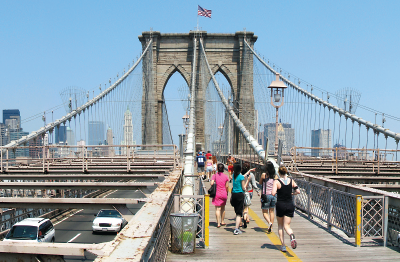Iconic Brooklyn Bridge Attracts Walkers and Students of City’s History
Abstract
Walking across the Brooklyn Bridge, just over a mile long, is one of those activities everyone should do once. Brooklyn Bridge Park, on the Brooklyn side of the East River, offers a new exhibit about the Brooklyn waterfront.
All that the [industrial] age had just cause for pride in—its advances in science, its skill in handling iron, its personal heroism in the face of dangerous industrial processes, its willingness to attempt the untried and the impossible—came to a head in Brooklyn Bridge.”

So wrote architectural critic Lewis Mumford in the 1920s, as quoted in historian David McCullough’s magisterial account of the building of the Brooklyn Bridge, The Great Bridge.
“The stone plays against the steel,” Mumford wrote. “[T]he heavy granite in compression, the spidery steel in tension. In this structure, the architecture of the past, massive and protective, meets the architecture of the future.”
The Brooklyn Bridge, spanning the East River and connecting Manhattan and Brooklyn, is an icon of New York City and is widely regarded as one of the most elegant architectural achievements of the 19th century. First opened for traffic in 1883, the bridge was the work of thousands of laborers over 14 years. Its chief architect and engineer was Washington Roebling, a veteran of the Civil War who fought at Gettysburg and Chancellorsville.
Among the epic feats involved in building the bridge was the sinking of two enormous “caissons” into the East River to serve as foundations for the bridge. Picture a breadbox the size of a football field constructed of treated southern yellow pine (an especially dense form of timber). The box was lowered through the water, open end down, onto the sediment of the river floor; compressed air was pumped into the caissons, and workers were lowered into the open space of the box to dig out the sediment until the caissons hit bedrock. The caissons were then filled with concrete and stone towers supporting the bridge on both sides of the river were built on top of the sunken caissons.
Many workers emerged from the experience with “the bends” (or caissons disease, as it was originally called). Roebling himself would fall victim to the condition and would be so disabled that he had to supervise the construction of the bridge from his apartment with the help of his wife.
Just over a mile long, the bridge can be entered from the Manhattan side at the juncture of Park Row and Centre Street in the Bowery neighborhood (across from City Hall). On the Brooklyn side, visitors can enter the bridge walkway at Cadman Plaza East near Prospect Street.
The pedestrian walkway allows spectacular views of Lower Manhattan and other city landmarks, such as the Statue of Liberty and Governors Island. The bridge entry in Manhattan is accessible by public transportation, with several subway stops nearby (the closest is Brooklyn Bridge/City Hall on the 4, 5, or 6 train lines).
More information
Just over a mile long, the Brooklyn Bridge can be entered from the Manhattan side at the juncture of Park Row and Centre Street in the Bowery neighborhood (across from City Hall). On the Brooklyn side, visitors can enter the bridge walkway at Cadman Plaza East near Prospect Street.
Brooklyn Bridge Park is located at 334 Furman Street.
More information about Free Tours by Foot can be accessedhere.
Countless commuters and sightseers cross the bridge every day, free of charge. Those looking for a group tour across the bridge may want to check out Free Tours by Foot. The group offers free group walking tours every day at 9:30 a.m. of the Brooklyn Bridge, Brooklyn Heights, and the DUMBO neighborhood, where the Bridge ends in Brooklyn.
Visitors to the bridge may also want to drop in at Brooklyn Bridge Park, a nearly 85-acre expanse on the Brooklyn waterfront. Located in the park is Jane’s Carousel, which opened in 2011 after undergoing almost 30 years of renovations. The original 1922 structure has been repainted and embellished with 1,200 lights in a pavilion designed by Pritzker Prize–winning architect Jean Nouvel.
Brand new this year at the park is “Waterfront,” an exhibition and multimedia experience sponsored by the Brooklyn Historical Society, which brings to life the vibrant history of Brooklyn’s coastline through interwoven stories of workers, industries, activists, innovators, families, neighborhoods, and ecosystems. The exhibit is housed at the Brooklyn Historical Society DUMBO, 55 Water Street (just across from the park).
The culmination of four years of development and research, “Waterfront” is the first major exhibition on the history of Brooklyn’s coastline, housed in Brooklyn Historical Society DUMBO, a renovated 19th century warehouse building in Brooklyn Bridge Park.
“Waterfront” combines cutting-edge digital interactives with engaging story-telling to welcome visitors of a variety of ages and interests—it includes activities for children as young as 2 and thought-provoking history for adults. “Waterfront” features 12 concept areas, a few of which include the following:
At Water’s Edge. This seven-minute multimedia experience introduces visitors to the waterfront’s dynamic history through 10 historical moments, leaving them exhilarated by their time travels.
The Walled City. Centered on a large-scale 1879 image of Brooklyn’s coastline, this section immerses visitors in the sights, sounds, and smells of Brooklyn’s 19th-century warehousing district. Visitors explore hidden stories vital to understanding the culture and history of the Walled City—from Walt Whitman’s waterfront trysts to hidden graves near the present-day Brooklyn Navy Yard.
A Laboring Family. Here, visitors to the exhibit will hunt down details in documents and genealogical records to trace the story of a 19th-century Empire Stores dockworker, Michael Harkins, and his family.
Rising Waters. A touchscreen video installation features historians, business owners, politicians, scientists, and activists who explore key questions about climate change and sea level rise. ■



